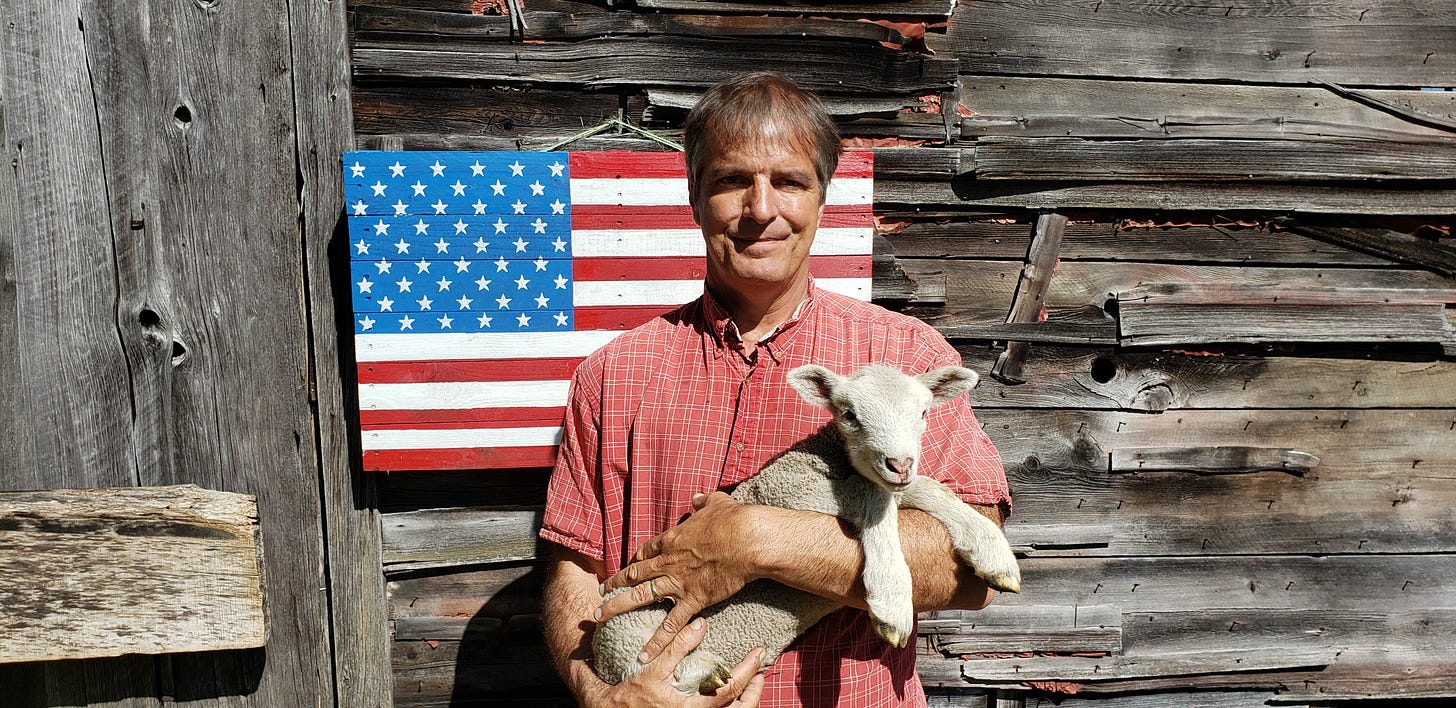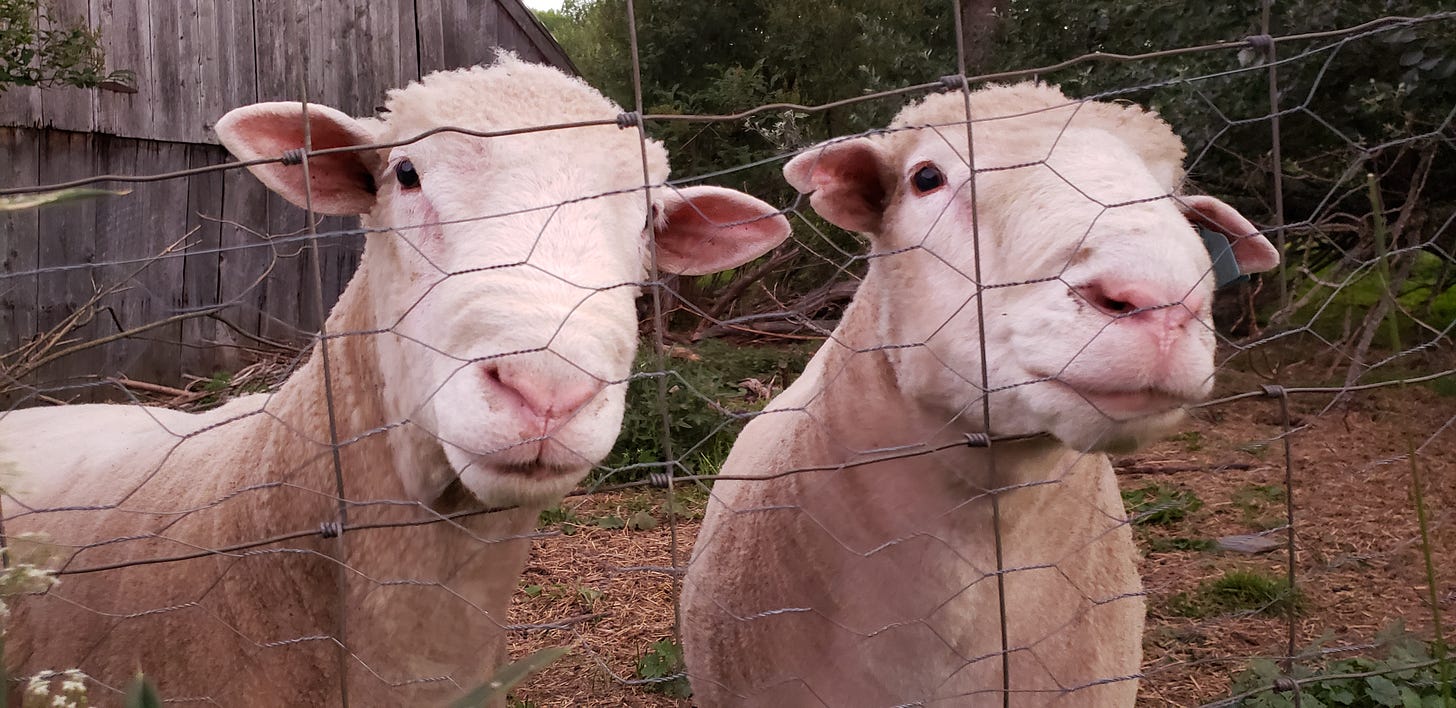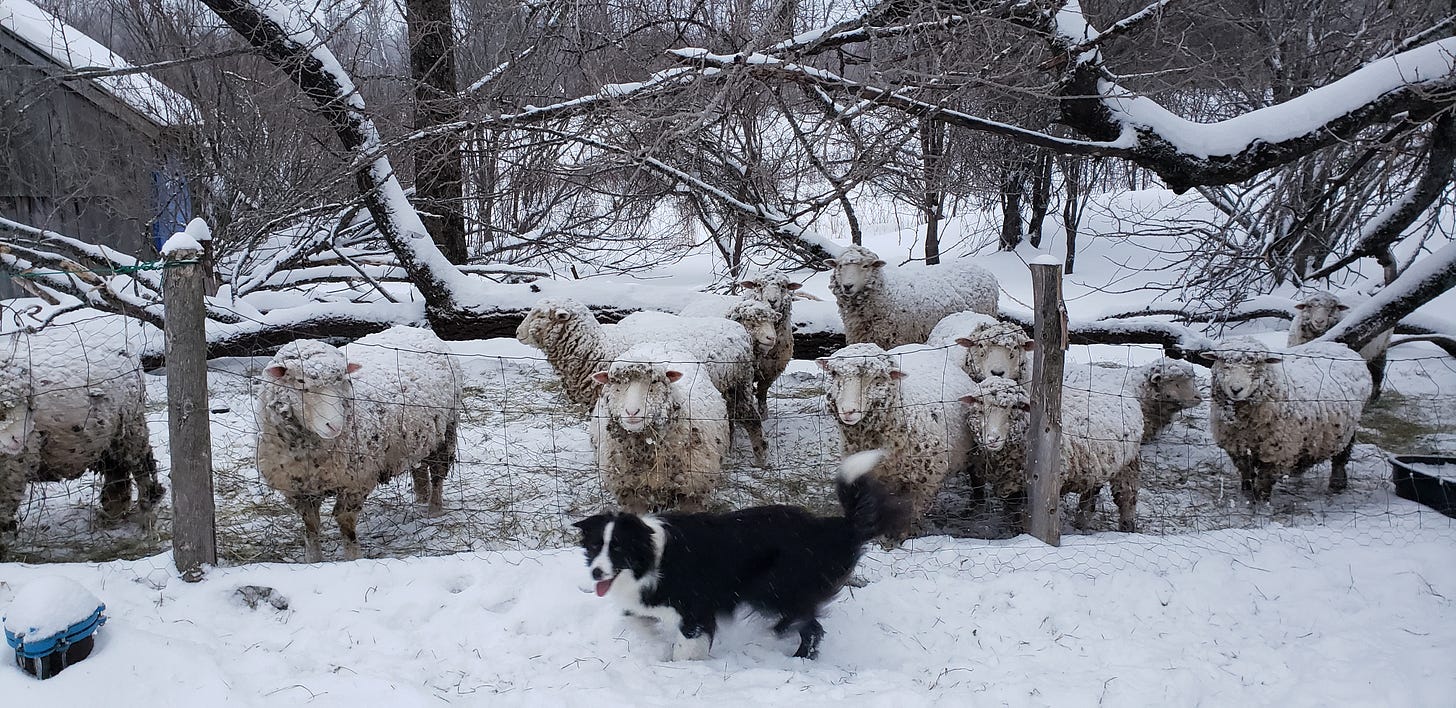[Below are my prepared remarks for Day One of the Liberty Food Fest in Bellows Falls, which, of course, bear little relation to what I actually said. My references to Joel are to my fellow speaker and ally Joel Salatin, who spoke before me at the Liberty Food Fest. Thanks to Amy Hornblas for the audio recording: details of her work are below.]
The recording of my talk is as much a comedy show as a farming spiel… :)
(I discussed trucking hay at the Liberty Food Fest, and when I turned around this picture was up on the screen. As can be heard in the audio, the crowd mirthfully enjoyed my self-deprecating remarks about this photo. My border collie Belle’s face kind of says a thousand human words….)
Before the event, my daughter Emily asked me what I was speaking about. I said I was following Joel and she said that’s tough, to follow Joel (which it really is!). She paused and then said, “I guess that’s OK because you’re eccentric.” I laughed, promptly retorting, “I’m eccentric? More eccentric than the self-described lunatic Christian libertarian farmer?!”
“That’s true,” Emily replied. “But Joel is a calm eccentric, and you are a hyper-manic eccentric, so I guess that works….”
I consider it a personal challenge to roast Joel a tad every time I speak with him. He is very good-natured about it, so he can hardly blame me that I take such relish in trying to make fun of him. But of course, it is in good fun and arises from affection.
There’s nothing like a good roast, well done.
How many people here have sheep? How many of you feel like you are sheep, squeezed ever more off grazing pastures and into a confinement feeding operation?
I’m going to talk about rearing sheep today, but in a big-picture way that includes everyone. I’ve also been asked to speak about hay. The two subjects go together, and this Vermont forum is a perfect place to consider them both.
I was raised in both Vermont and CT, kind of a split cultural personality disorder. I have always had my head and heart in both farming and the “modern world.” My grandmother Cesarine Stoddard used to tell her kids, and then her grandkids – “There’s no money in Vermont or farming and there never will be. The best thing you can do when you turn 18 is get out of Vermont.” Most did, though some came back. Grammie was in a way right, but in a way we will discuss here, she was wrong. She, too, was a product of her time.
(Some of our Dorset ewes enjoying Vermont winter.)
Let’s talk about Grammie’s time. I interview old farmers. Roland is 97; I knew farmers in their 80s and 90s 50 years ago – they would be closer to 140 now. What stories would they tell, what knowledge did they take with them, like our lost heirloom seed varieties? Is it important for our modern times? Perhaps it is more important than any other single area of our supposedly amazing knowledge base. Microbiome…
Subscribe to Small Farm Republic to unlock the rest.
Become a paying subscriber of Small Farm Republic to get access to this post and other subscriber-only content.
Vermont is an unusual place – I call it the land of the lost (after the 1970s TV show where a family gets locked in prehistoric times.) Everything that left Vermont behind from development – tall mountains, muddy roads, bitter winters – are now liabilities for which we ought to be thankful. Thankful we haven’t paved or subdivided every square inch of usable farmland. Grateful we still have the ability to produce domestic food.
Those mud, winter, and mountain problems have always been the economic bane of Vermont. Subsistence farmers who were still largely subsisting when the Great Depression hit. 27,000 dairy farms in 1929; now 550. We can lament their passing, but they aren’t done leaving. Consider the impact and focus of agriculture in this Green Mountain State. It began with sheep….
By 1837. there were over one million sheep in Vermont providing wool to the large textile mills in Massachusetts and over 100 smaller mills in Vermont. There were an estimated 1.6 million sheep in Vermont in 1850, a 6: ratio to humans
The Spanish Sheep Craze That Forever Changed Vermont - New England Historical Society
“Then came the economic crisis caused by the Embargo Act of 1807 and the Nonintercourse Act of 1809. Wool factories could no longer buy wool from Britain, and farmers could no longer sell their grain overseas.
Merino mania then seized Northern New England, especially Vermont. Textile manufacturers paid farmers $2.00 for a pound of merino wool, while common wool sold for 37.5 cents a pound. Common sheep sold for $2, while Merino rams sold for as much as $1,500 each.
Farmers stopped growing wheat and grain and started raising the Spanish sheep. They cut down thousands of acres of trees because the sheep needed the land for grazing.
The craze subsided by 1823. Isaac Holmes wrote, in An Account of the United States of America, derived from actual observation, during a residence of four uears in that Republic; including Original communications,
The sheep or Merino mania has now subsided. Four or five years ago, the sum of 1500 dollars was paid for a ram of the Merino breed. One thousand dollars was a very common price for an animal which would not now sell for fifty.
Prices fell from 57 cents a pound in 1835 to 25 cents in late 1840, and two-thirds of Vermont’s sheep were killed between 1846 and 1850. Many farmers went out of business.
(Our border collie Bea loves helping with the sheep.)
A second wave of Merino mania struck in the 1860s. Cotton was scarce and wool was needed for military uniforms due to the US Civil War. The sheep population doubled in some places. Some Vermont Merino rams sold for as much as $5,000.”
This is sheep for profit and wool. Imagine what a breeding ram would cost if it were for food and there were widespread food shortages and a dearth of available livestock. More like buying a life preserver when the Titanic sinks, or a parachute while the plane goes down. Currently, the American farming and food system is that plane; it is the Titanic.
I grew up working, hard. Construction, stacking wood, landscaping, cooking and washing dishes (and waiting and busing tables) at restaurants, and foundation work. I even hitch-hiked cross country when I was 19. Then I got a chance to attend college, and from there law school. I didn’t really want to be a lawyer, but I knew that no matter what I did the law applies, and that to know the law opened all the doors to our society. It’s true. And now we are living in a time when he who controls the law controls the food. There is no right to grow or eat what you want in the US Constitution – laws restrict raw milk, slaughter, what I can sell for meat and veggies. Vermont law now controls cannabis sales for 21% sales tax and astronomical banking fees. USDA, FDA, and EPA control what is in your food – lawyers and bureaucrats have become the farmers. Zurich, BASF, Bayer and other multinational cop-rporations are planning the global food system at the WEF. Literally, they say we must consolidate all global food production under the industrial agricultural method to “save the world and feed from climate change and prevent famine.” Both claims are demonstrably specious: industrial agriculture is profitable for the “stakeholders” but it is destroying ecosystem and human health.
He who controls the food, controls the people, right? Or in the end, is everything upside down, and he who controls the food controls the law? Let’s consider ancient Rome and its bickering Senators, and today’s city mice politicians and urban-dwellers telling farmers how to raise cows… or sheep. Who do you think prevailed when Rome fell, the barbarians with food, or the wealthy Roman Senators with big words and lists of laws and edicts? This isn’t just about survival but about leadership. We don’t have dairy farmers sit as judges; why do we have lawyers, bankers, and billionaires controlling food supplies, at all of our peril?
(Stay tuned for Part Two of A Case for Sheep!)
Audio credit:
The 5 H Show Celebrates Health, Happiness, Harmony, Humor and Humanity
Hosts Geri Proccachini and Amy Hornblas discuss issues related to The 5 H’s with neighbors from the Mad River Valley in Vermont, across New England- and beyond.
The 5 H Show is produced at a community radio station in Warren, Vermont. Listen Live, and also check out the other Great Programming on WMRW: wmrw.org
A collection of previous episodes of The 5 H Show are also free for download at AMYVT.COM







